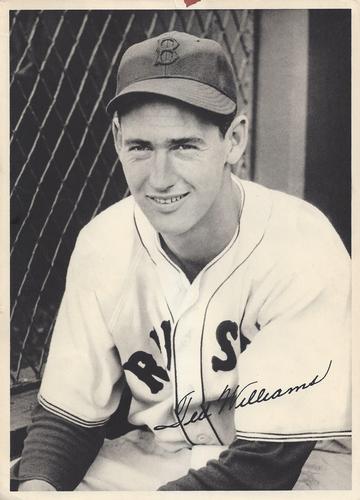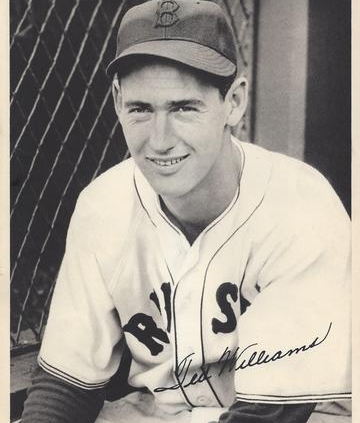May 16, 1942: Helping build his first Triple Crown year, Ted Williams homers to beat the Browns
 It was home run number 99 in Ted Williams’s Boston Red Sox career, and the third he had mashed off Bob Muncrief of the St. Louis Browns.1 It was his 19th game-winning homer,2 this one hit in the ninth inning of the Saturday afternoon game at St. Louis’s Sportsman’s Park. The win ended a five-game Red Sox losing streak.
It was home run number 99 in Ted Williams’s Boston Red Sox career, and the third he had mashed off Bob Muncrief of the St. Louis Browns.1 It was his 19th game-winning homer,2 this one hit in the ninth inning of the Saturday afternoon game at St. Louis’s Sportsman’s Park. The win ended a five-game Red Sox losing streak.
Williams came into the May 16 game batting .287 during the 1942 season’s first month of play, down more than 100 points from the .406 batting average he had posted in 1941. Muncrief, a 26-year-old right-hander, was coming off a 13-9 (3.65) season, the first of four seasons from 1941 through 1945 in which he won 13 games, his career best. He wasn’t faring as well in 1942 and came into this game with a 1-3 record and a 4.06 ERA.
Muncrief was pitted against Tex Hughson, who was without a decision so far in the season. Hughson had appeared in five prior games in 1942 – his first full major-league season – but had suffered arm troubles in spring training and this was his first start of the season. He had been 5-3 in 12 games in 1941.
The managers were Luke Sewell for the Browns and Joe Cronin for the Red Sox.
Throughout the game, Muncrief saw a lot of Boston batters reach base, while Hughson allowed just seven St. Louis batters to reach.
First to score were the Red Sox with two runs in the top of the fourth. To that point, there had been a leadoff double by rookie shortstop Johnny Pesky, on his way to a major-league-leading 205 base hits. There had been a two-out double by center fielder Dom DiMaggio in the second inning. And Ted Williams had drawn a base on balls in the third. They were the only Red Sox to reach base over the first three innings.
The Browns were set down in order in the first and second. Leading off the third, Vern Stephens drew a walk. After catcher Bob Swift flied out to Lou Finney in right field, Muncrief bunted to try to move Stephens to second. He succeeded – and reached safely himself, due to an error by first baseman Tony Lupien. Second baseman Don Gutteridge flied out to left. Third baseman Harlond Clift grounded out, unassisted, to Red Sox third baseman Jim Tabor.
Come the top of the fourth, second baseman Bobby Doerr swung at the first pitch of the inning and hit a home run that according to the Boston Herald landed “half way up into the left-field bleachers.”3 Tabor singled to left – off the wall and missing a home run by only about a foot – but was cut down trying to stretch it into a two-base hit. DiMaggio walked. On a hit-and-run play, catcher Johnny Peacock singled and DiMaggio went first to third. Hughson took a called third strike and there were two outs. Pesky grounded to first base, where George McQuinn misplayed it. Pesky was safe on the error and DiMaggio scored. Finney made the third out. It was 2-0.
McQuinn reached first on a one-out walk in the bottom of the fourth, but right fielder Glenn McQuillen hit into a 6-4-3 double play.
Ted Williams led off the fifth with a single. Lupien singled and Williams pulled up at second. Two outs followed, and when DiMaggio singled and Williams tried to score, the Red Sox slugger was out at home plate.
Hughson got himself in trouble by walking the first two batters in the bottom of the fifth, center fielder Chet Laabs and Vern Stephens. Swift bunted and both baserunners moved up, but the next batter was Muncrief and he popped up foul to Peacock. Gutteridge produced, though, swinging at Hughson’s first pitch and hitting a two-run single to center field that tied the game, 2-2. Clift popped up to Doerr at second base.
Neither team scored in the sixth, seventh, or eighth, though there were scoring opportunities. With one out in the sixth, Hughson walked, Pesky doubled, and Finney reached on an infield single when the first baseman and third baseman collided, the ball dropping in. The bases were loaded for Ted Williams, but he hit to the first baseman, starting a 3-6-1 double play.
Left fielder Roy Cullenbine walked leading off the St. Louis half of the sixth. He was sacrificed to second, but the next two Browns made outs and the inning was over.
Lupien, Doerr, and Tabor went down in order in the Red Sox seventh, the latter two striking out on three pitches each. It was the only inning of the game in which the Red Sox didn’t leave a man on base. Everyone in the Red Sox lineup had at least one base hit, except Hughson.
There was yet another sacrifice in the St. Louis seventh (this was the fourth of the game by the Browns), laid down by Swift after Vern Stephens hit a single, a Texas Leaguer into right field. Neither Muncrief nor Gutteridge could get Stephens home, however.
The score remained 2-2. At bat with one out, Peacock singled in the eighth. Hughson sacrificed him to second, but Pesky hit into an out and ended the inning. No one reached base for the Browns.
In the top of the ninth, Lou Finney doubled to left field. Ted Williams wasn’t about to be asked to sacrifice. Instead he hit a home run. After fouling off the first pitch, he “shattered the two-all tie to wee bits by slamming a fast ball, away from him, onto the top of the right center field pavilion.”4 The ball left Sportsman’s Park “over the roof in right-center over the 354-foot mark.”5
After Lupien made an out, Doerr walked, and a pitching change seemed in order. Muncrief was out and Loy Hanning was called in. Hanning had appeared in four games for the Browns back in 1939. He was 0-1. He’d spent 1940 and 1941 with San Antonio in the Texas League. This was just his second appearance in 1942. He’d pitched well – two innings with just one hit against the Philadelphia Athletics on May 12. He pitched well enough here, retiring Tabor, allowing a single to DiMaggio, and then getting Peacock out.
The game entered the bottom of the ninth.
To this point, Hughson had allowed only two hits, Gutteridge’s two-run single in the fifth and the leadoff single by Stephens in the seventh. He had walked five Browns batters, though. And the Red Sox led by only two runs despite having 14 base hits and five walks. They had left 13 on base.
Wally Judnich had come into the game to play center field in the top of the ninth. He was first up. He lined out to Pesky at short. Laabs grounded to short but reached second when Pesky’s low throw to first eluded Lupien. Stephens popped up to Pesky for the second out. Babe Dahlgren, who had just been acquired from the Chicago Cubs, pinch-hit for Swift, flied out to center field, and the game was over.
Hughson had his first win of the year. He won 21 more games in 1942, leading both leagues. He threw 22 complete games, worked 281 innings and struck out 113 opponents. He led the American League in all those categories.
Ted Williams was on his way to a Triple Crown year, leading the league in home runs (36), RBIs (137), and batting average (.356). His average was 50 points lower than the .406 he hit in 1941, but the success he had in all three categories led both the AL and NL. The home run he hit in this game was the first of six game-winning homers he hit in 1942. The Red Sox finished in second place, nine games behind the New York Yankees.
Acknowledgments
This article was fact-checked by Victoria Monte and copy-edited by Len Levin.
Photo credit: Ted Williams, Trading Card Database.
Sources
In addition to the sources cited in the Notes, the author consulted Baseball-Reference.com and Retrosheet.org.
https://www.baseball-reference.com/boxes/SLA/SLA194205160.shtml
https://www.retrosheet.org/boxesetc/1942/B05160SLA1942.htm
Notes
1 Williams later hit homers number 177, 187, and 195 off Muncrief.
2 A “game-winning home run” is defined here as a home run that provides a game’s final margin of victory, giving the winning team at least one more run than the opposing team scored. For example, if a two-run homer increased a team’s lead from 2-1 to 4-1, and it went on to win 4-3, it qualifies as a game-winning home run. (This is different from the definition of “game-winning RBI” in baseball’s official statistics from 1980 through 1988, which counted as “game-winning” the RBI that provided a winning team a lead that it never relinquished.)
3 Burt Whitman, “Tex Hughson Gives 2 Hits in 4-2 Victory,” Boston Herald, May 17, 1942: 39, 40.
4 Whitman.
5 Harold Kaese, “Hughson Allows Only Two Hits,” Boston Globe, May 17, 1942: B24.
Additional Stats
Boston Red Sox 4
St. Louis Browns 2
Sportsman’s Park
St. Louis, MO
Box Score + PBP:
Corrections? Additions?
If you can help us improve this game story, contact us.


